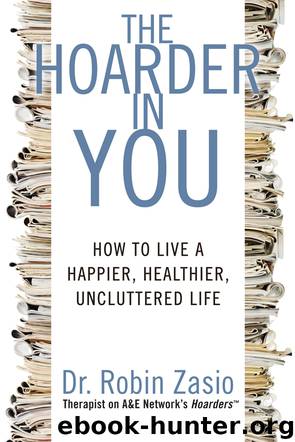The Hoarder in You by Robin Zasio

Author:Robin Zasio
Language: eng
Format: epub, mobi
Publisher: Rodale
Published: 2011-04-22T16:00:00+00:00
EXPOSURE AND COMPULSIVE HOARDING
Exposure is the behavioral component used in CBT to help those struggling with compulsive hoarding learn how to manage the negative emotions that inevitably surface when facing and confronting their fears. Take, for instance, a person who is willing to drive past a garage sale without stopping, resist walking into a store that reads “closeout,” or pass on a wicker basket that his neighbor is discarding. It’s quite likely that feelings of regret will surface, in addition to several cognitive distortions, which may include “There may have been a good deal at the garage sale and I’ll never know”; “I missed my opportunity to go to the closeout and will never forgive myself”; or “I should have taken the basket. My opportunity is lost forever.” These distortions will breed feelings of intense regret that I will ask my client to sit with. Typically, the feelings of doubt (not knowing what he missed) and fear (I’ll never get over it!) are not as bad as he anticipates, and the exposure of passing on these opportunities will ultimately help to test his fear about what he might feel, and in the long run, will keep the clutter down in the house.
Another example of exposure is getting rid of an item, and then sitting with the anxiety a person feels when he endeavors not to retrieve it. The experience might be one of loss, feeling like he can never get it back and will forever be without it. It can be quite challenging, which is why I prefer to start the exposure process on an item that my client would not feel particularly anxious about giving up. As I did with Jason, I ask clients to rate how anxious they anticipate they’d feel on a scale of 0 to 10 (0 equals no anxiety; 10 equals potential panic; and 5 is the middle, an experience of moderate anxiety). If an item is on the low end, a 2 or a 3, I start there. Once the client learns that he can manage his anxiety, we will work through the lower-level triggers (items) until he is ready to move to the next level.
There are some therapists who believe in “flooding,” which is to address the items that the client has high levels of anxiety about right out of the gate. The belief is that by asking the client to face his highest anxiety first, it makes dealing with the lower-level items much easier. While this can be true, I feel that there is considerable risk involved in doing exposure in this manner. The reason is that when we feel anxious, our nervous systems alert us to potential danger. We need to respond in one of two ways: fight or flight. If the exposure exercise that the individual is asked to do—giving up an item that he thinks he couldn’t live without—results in too high a level of anxiety, there is a risk that the patient won’t be able to manage the anxiety, will retreat, and will terminate therapy.
Download
This site does not store any files on its server. We only index and link to content provided by other sites. Please contact the content providers to delete copyright contents if any and email us, we'll remove relevant links or contents immediately.
Should I Stay or Should I Go? by Ramani Durvasula(6823)
Why We Sleep: Unlocking the Power of Sleep and Dreams by Matthew Walker(5678)
Fear by Osho(4108)
Flow by Mihaly Csikszentmihalyi(4078)
Rising Strong by Brene Brown(3798)
Why We Sleep by Matthew Walker(3795)
Too Much and Not the Mood by Durga Chew-Bose(3707)
How to Change Your Mind by Michael Pollan(3695)
The Hacking of the American Mind by Robert H. Lustig(3597)
Lost Connections by Johann Hari(3465)
He's Just Not That Into You by Greg Behrendt & Liz Tuccillo(3323)
Evolve Your Brain by Joe Dispenza(3068)
What If This Were Enough? by Heather Havrilesky(2952)
Resisting Happiness by Matthew Kelly(2898)
Crazy Is My Superpower by A.J. Mendez Brooks(2877)
The Courage to Be Disliked by Ichiro Kishimi & Fumitake Koga(2818)
The Book of Human Emotions by Tiffany Watt Smith(2785)
Descartes' Error by Antonio Damasio(2757)
In Cold Blood by Truman Capote(2701)
